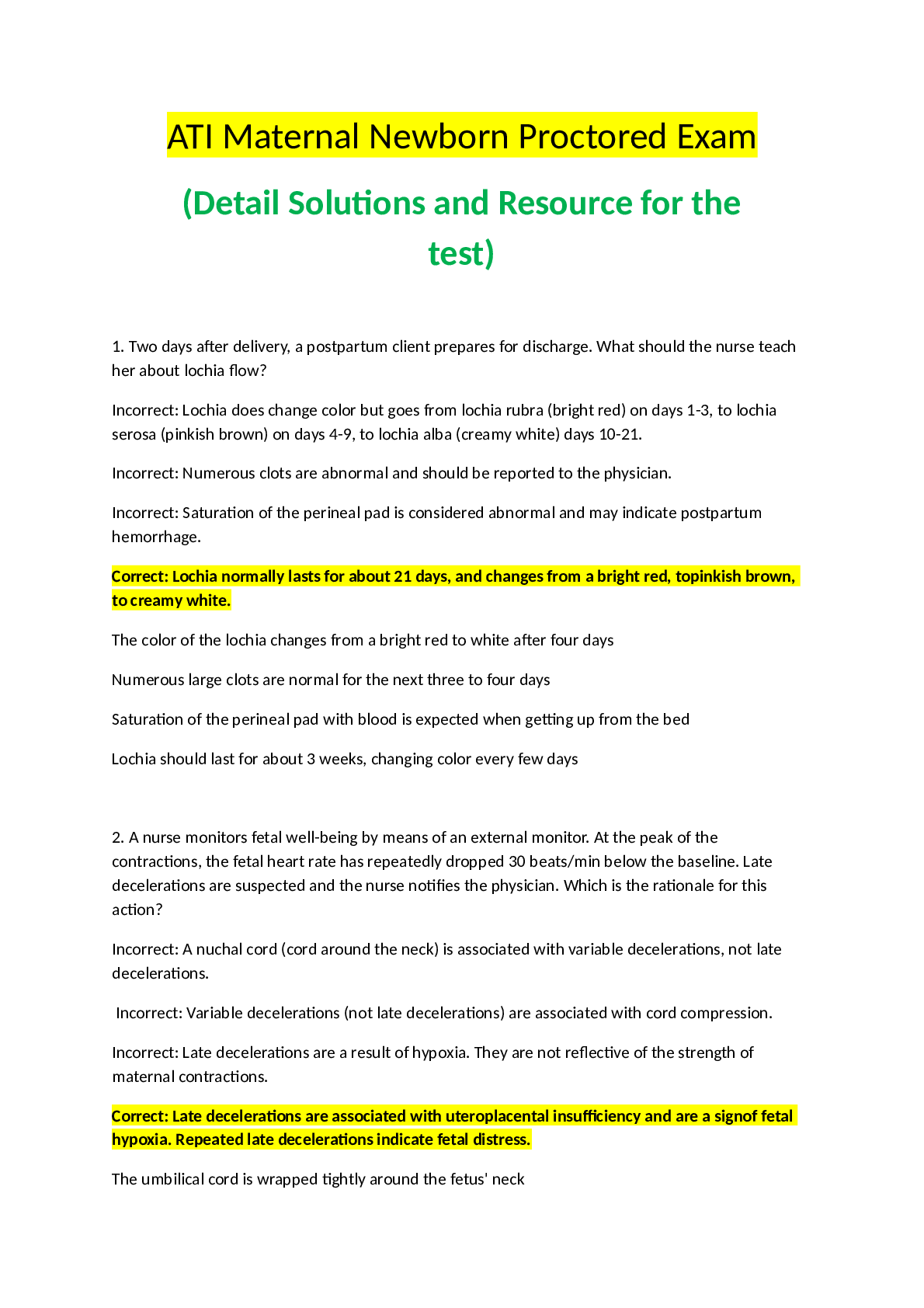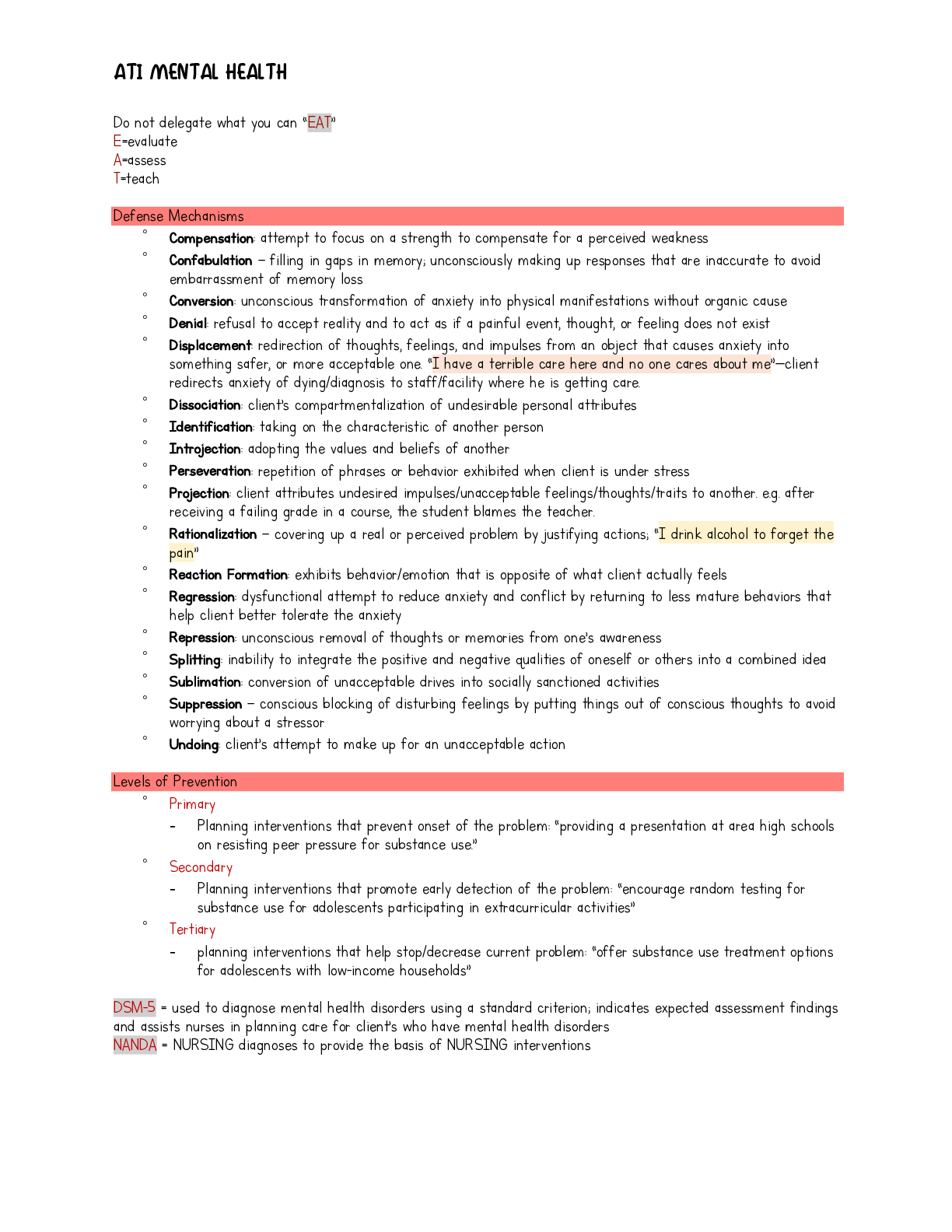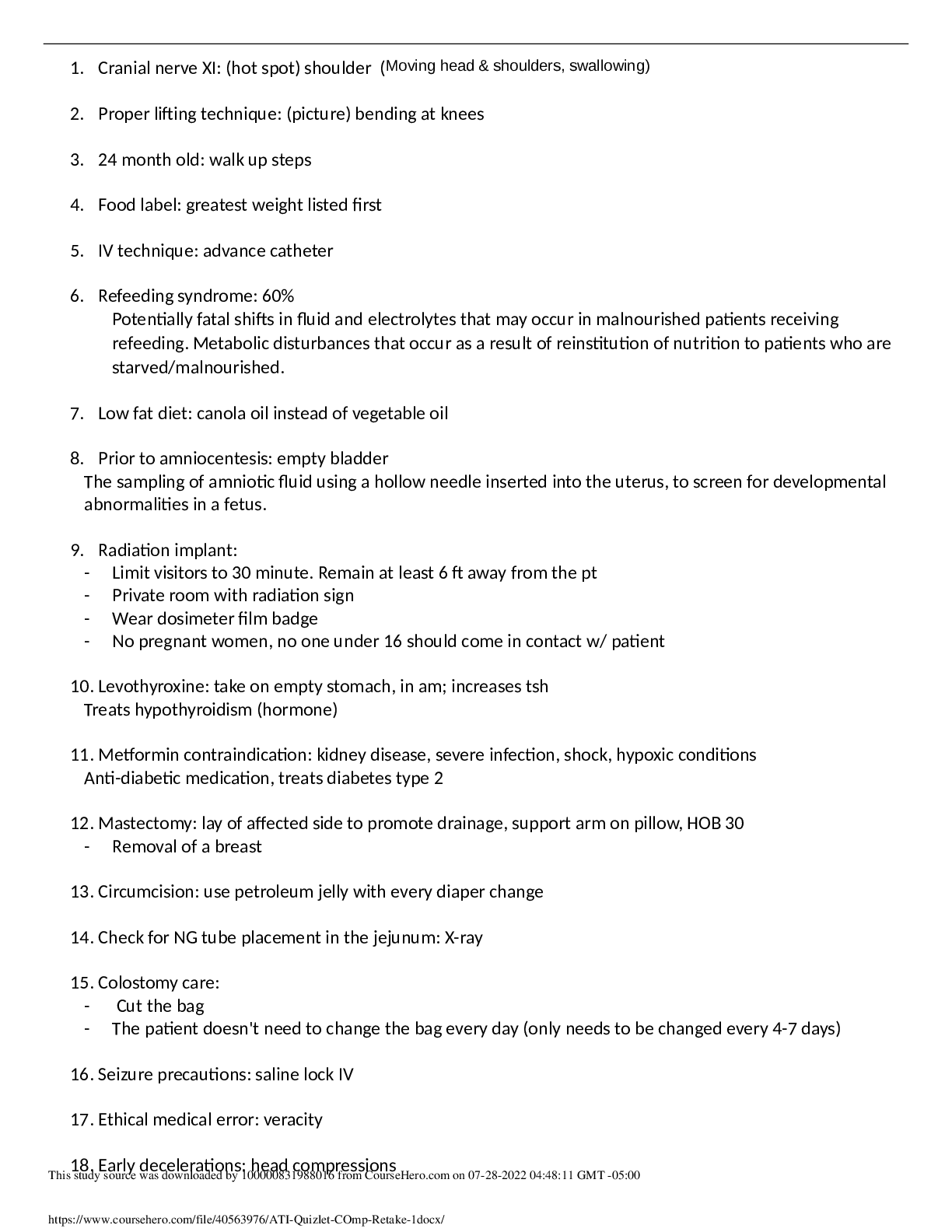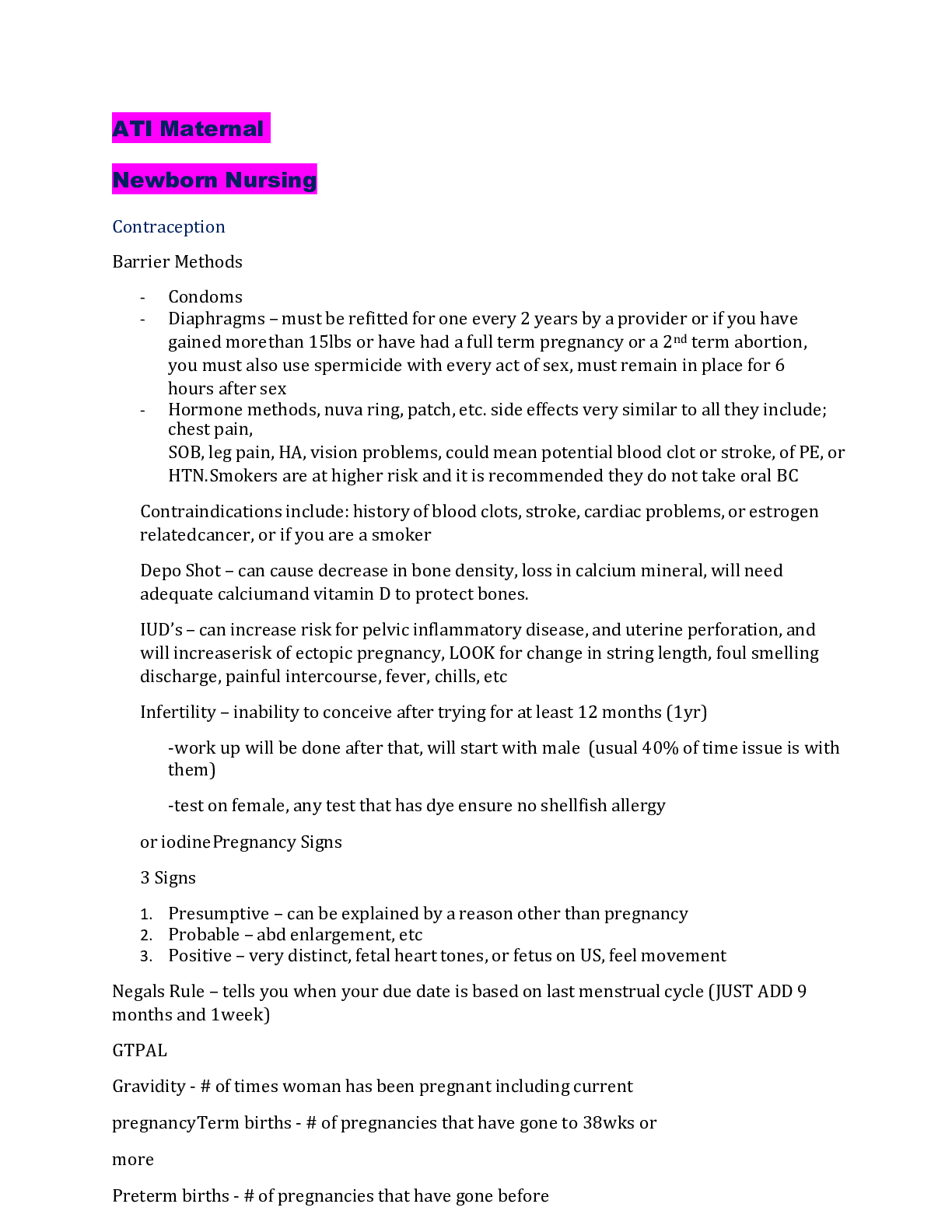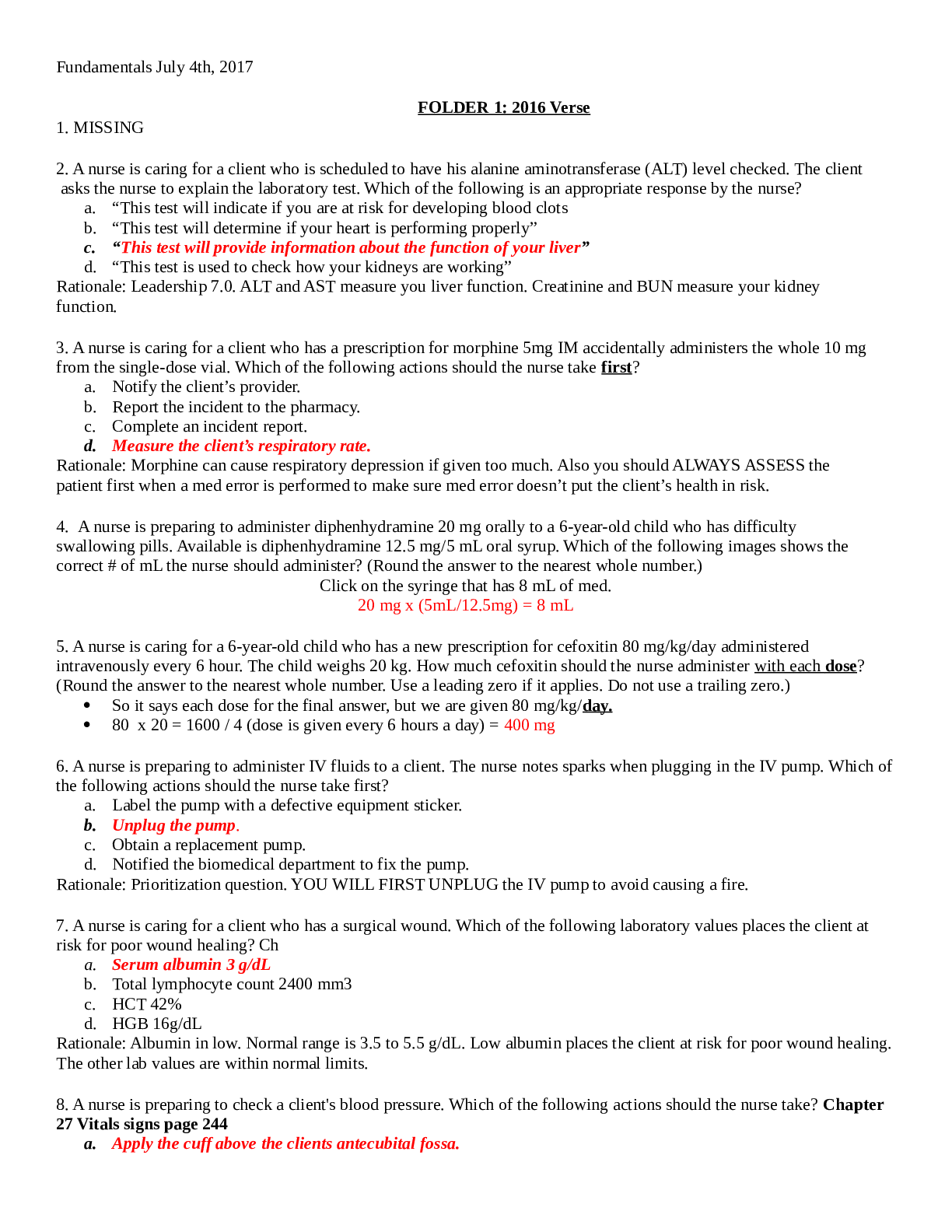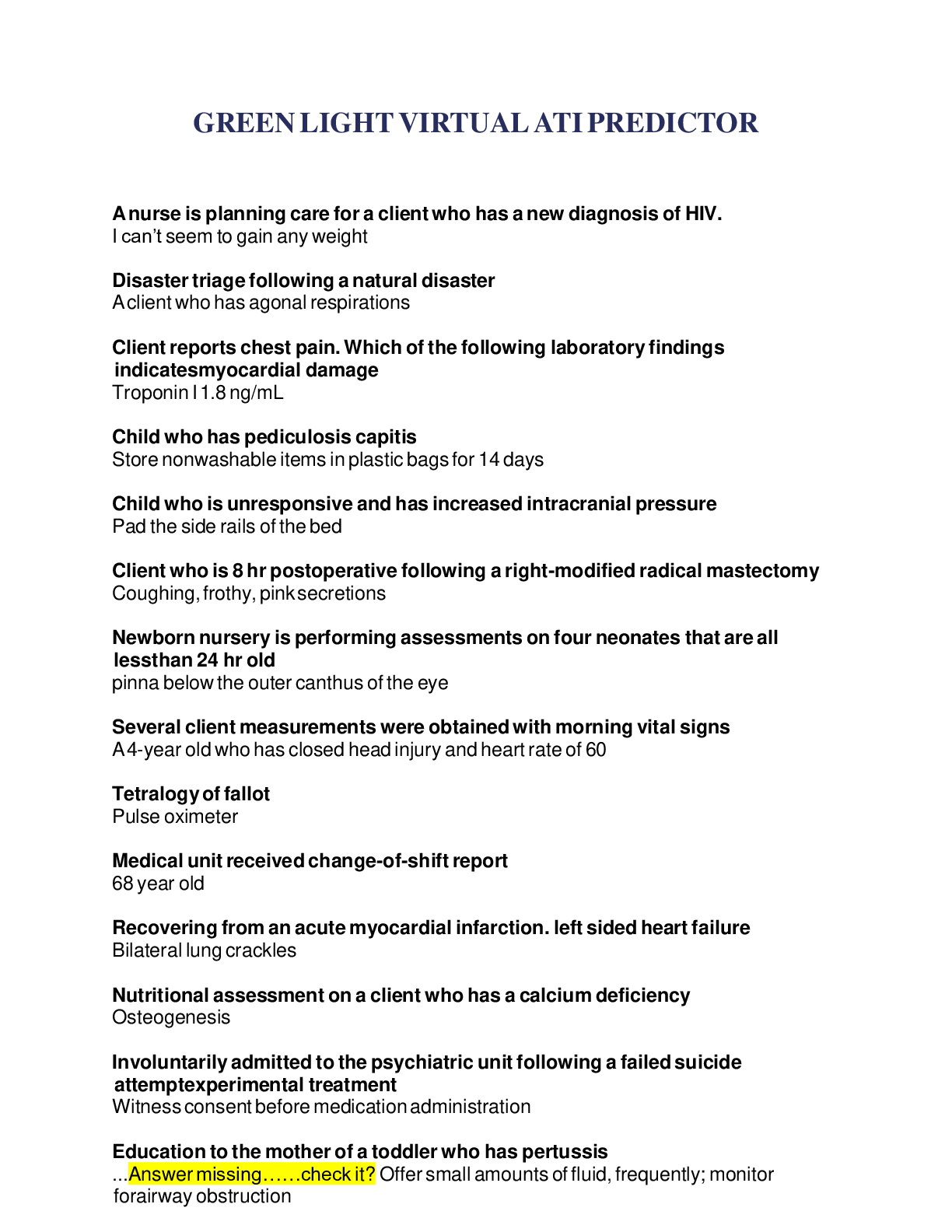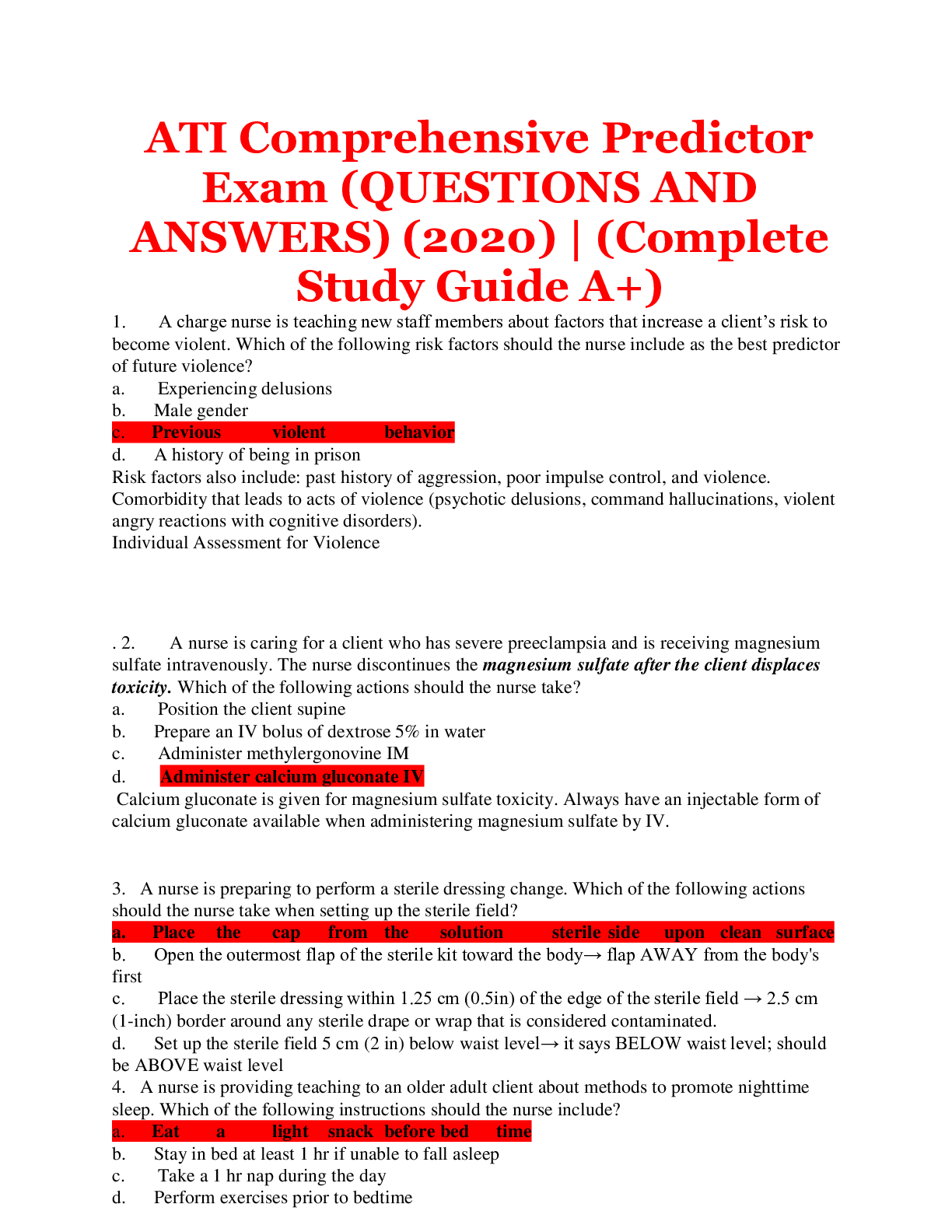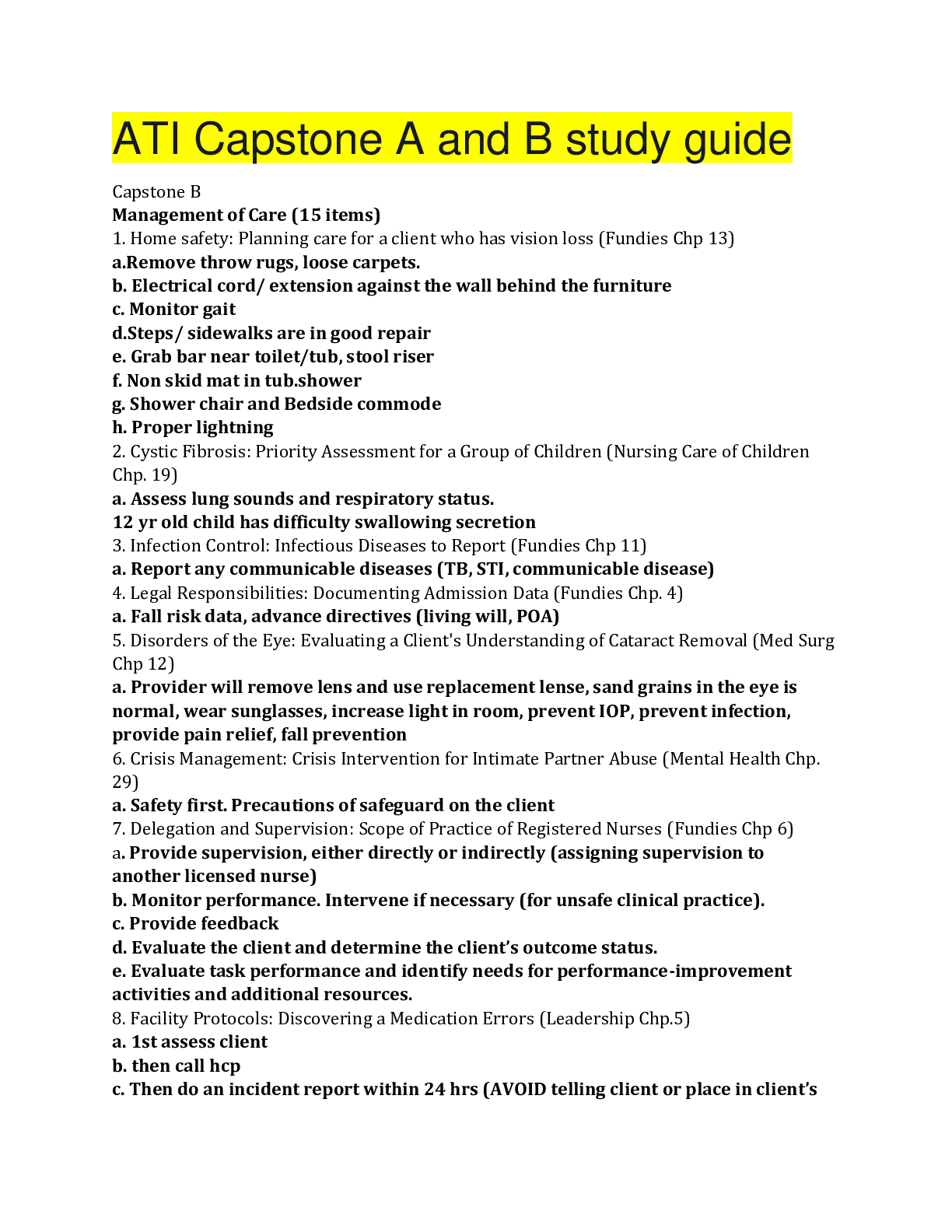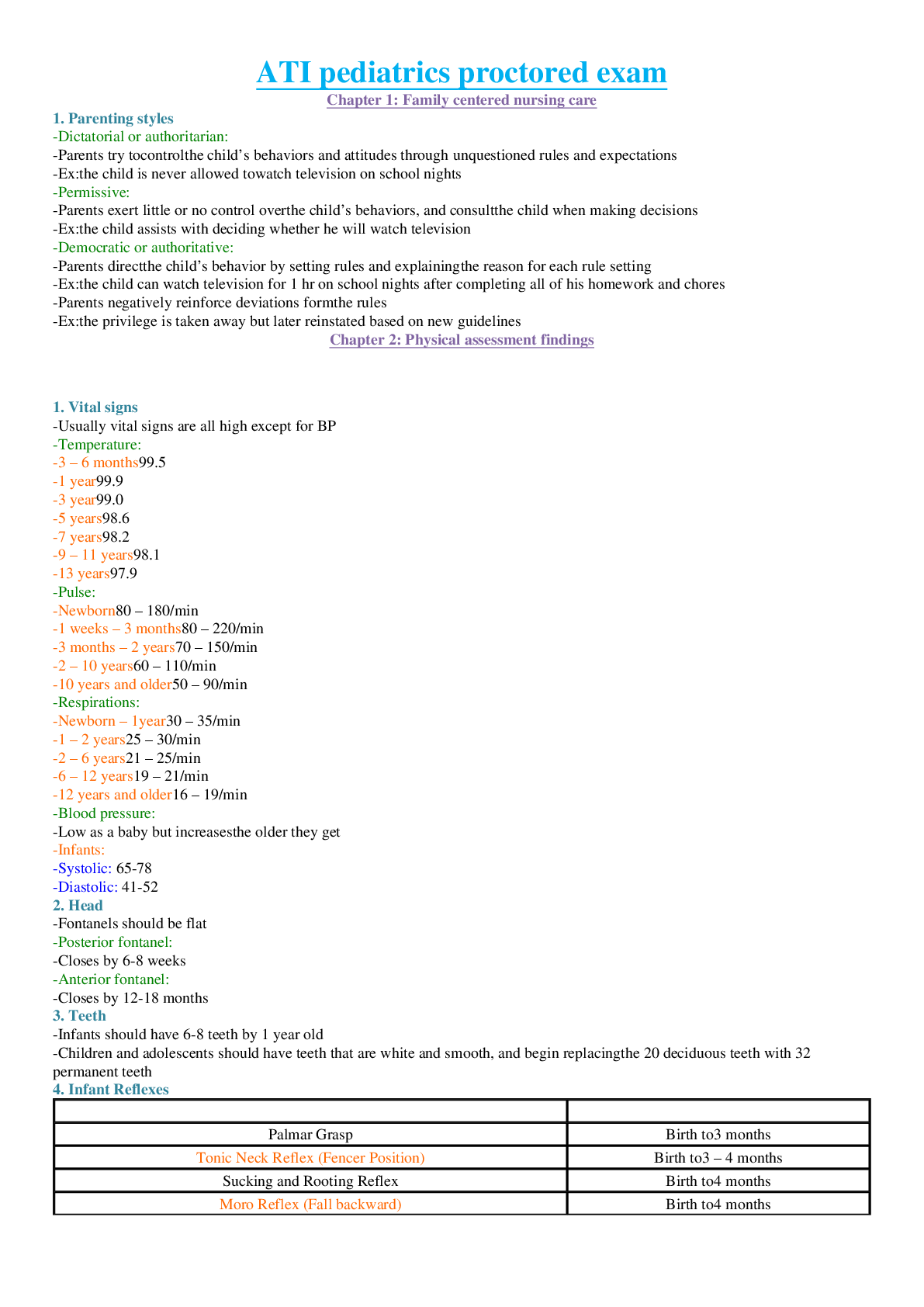*NURSING > QUESTIONS and ANSWERS > ATI oncology Chapter 89: General Principle of Cancer (All)
ATI oncology Chapter 89: General Principle of Cancer
Document Content and Description Below
ATI Chapter 89: General Principle of Cancer • Cancer is a neoplastic disease process that involved abnormal cell growth and differentiation. • NORMAL body cells grow, divide, and die in an ord... erly fashion. • In cancer cells, dying cells grow and form new abnormal cells and can form new blood vessels to provide nourishment for continued growth. • Cancer cells can invade surrounding tissue and spread to other areas of the body through lymph and blood vessels (metastasis) • No matter where cancer spreads, it ALWAYS is named based on the ORGIN FROM WHICH IT STARTED • Body Tissues: o Epithelial Tissue: carcinomas o Glandular Organs: adenocarcinomas o Mesenchymal Tissue: sarcomas o Blood-forming cells: leukemias o Lymph Tissue: lymphomas o Plasma cells: myelomas • Health Promotion: o Chemoprevention is the use of medication or other substances to disrupt cancer development: ▪ ASA and celecoxib to reduce the risk of colon cancer ▪ Vitamin D and tamoxifen to reduce the risk of breast cancer o Immunization to prevent HPV, which is associated with cervical, head, neck cancers o Immunization for Heb B to prevent liver disease which can progress to liver cancer • Screening Recommendations: o Mammogram: annually 45-54 years o Clinical breast exam: every 3 years for age 20-39, annually for over 40 years o Colonoscopy: at age 50 than every 10 years o Prostate: annually for males 70 years and older o Pap: every 3 years for 21-29, clients 30-65 every 5 years • Expected Findings: o Benign Tumors: often slower growing having localized effects o Malignant: often grow very rapidly if they are more abnormal • Staging of Tumor: tumor-node-metastasis (TNM) system is used to stage cancer o Tumor (T): ▪ TX: unable to evaluate the primary tumor ▪ TO: no evidence of primary tumor ▪ Tis: tumor is situ ▪ T1, T2, T3, T4: size and extent of tumor o Node (N): ▪ NX: unable to evaluate regional lymph nodes ▪ NO: no evidence of regional node involvement ▪ N1, N2, N3: number of nodes that are involved and extent of spread o Metastasis (M): ▪ MX: unable to evaluate distant metastasis ▪ MO: no evidence of distant metastasis ▪ M1: presence of distant metastasis • Grading: well differentiated (means cells look much like normal cells and tend to grow slowly). Undifferentiated (means the cells do not look like normal cells and tend to grow quickly and spread) o GX: grade cannot be determined o G1: tumor cells are well differentiated o G2: tumor cells are moderately differentiated o G3: tumor cells are poorly differentiated, but the tissues of origin can be established • Complications: o Constipation, gastric stasis, intestinal obstruction: administer stool softeners & laxities, encourage fluids, fiber, activity as tolerates o Paraneoplastic Syndrome: results when T cells in the body attack normal cells rather than cancerous ones. Manifestations of neurologic function changes. • Oncologic Emergencies: o SIADH: occurs with excessive levels of ADH causing the body to retain water. Key findings: nausea, vomiting, lethargy, hostility, seizures, coma ▪ Administer furosemide, 0.9% sodium chloride IV o Hypercalcemia: anorexia, n/v, shortened QT interval, kidney stones, bone pain, altered LOC. Administer 0.9% sodium chloride IV, furosemide, pamidronate o Superior Vena Cava Syndrome: results from obstruction of venous return and engorgement of the vessels from the head and upper body. ▪ Nursing Considerations: high fowlers position o Tumor Lysis Syndrome: occurs when tumors are rapidly destroyed which releases intracellular content into the bloodstream faster than the body can process them. It causes hyperkalemia, hyperphosphatemia, hyperuricemia. ▪ Manifestations: GI distress, flank pain, muscle cramps/weakness, seizures, altered LOC ▪ Nursing Actions: administer IV fluids, encourage fluid intake, administer medications (diuretics, allopurinol, sodium polystyrene) to reduce K+, uric acid, and phosphorus level. Chapter 90: Cancer Screening and Diagnostic Procedures Biopsy: provides definitive diagnosis indicating the sit of the origin (specific cell type) and cell characteristic (specific receptors on the cell surface) • Shave (basal or squamous cell skin): sampling outer skin layers (raised lesions) • Needle Biopsy (fine or core): aspiration of tumor close to skin surface for fluid and tissue sampline • Incisional/Excisional (open): cutting through skin to remove part/all of tumor • Sentinel lymph node biopsy: biopsy of lymph node closest to the cancer Labs: • Liver Function Test: elevation can indicate primary liver cancer • Tumor Marker Assay: detect the presence of normal body proteins at higher than expected levels Chapter 91: Cancer Treatment Options Cancer treatment is based on the cell of the origin of cancer, which focuses on removing or destroying cancer cells and preventing the continued abnormal cells growth and differentiation. Procedures: • Tumor Reduction: can be done through topical procedures (cryosurgery ........................................................................CONTINUED............................................................... [Show More]
Last updated: 1 year ago
Preview 1 out of 13 pages

Reviews( 0 )
Document information
Connected school, study & course
About the document
Uploaded On
Apr 18, 2021
Number of pages
13
Written in
Additional information
This document has been written for:
Uploaded
Apr 18, 2021
Downloads
0
Views
34


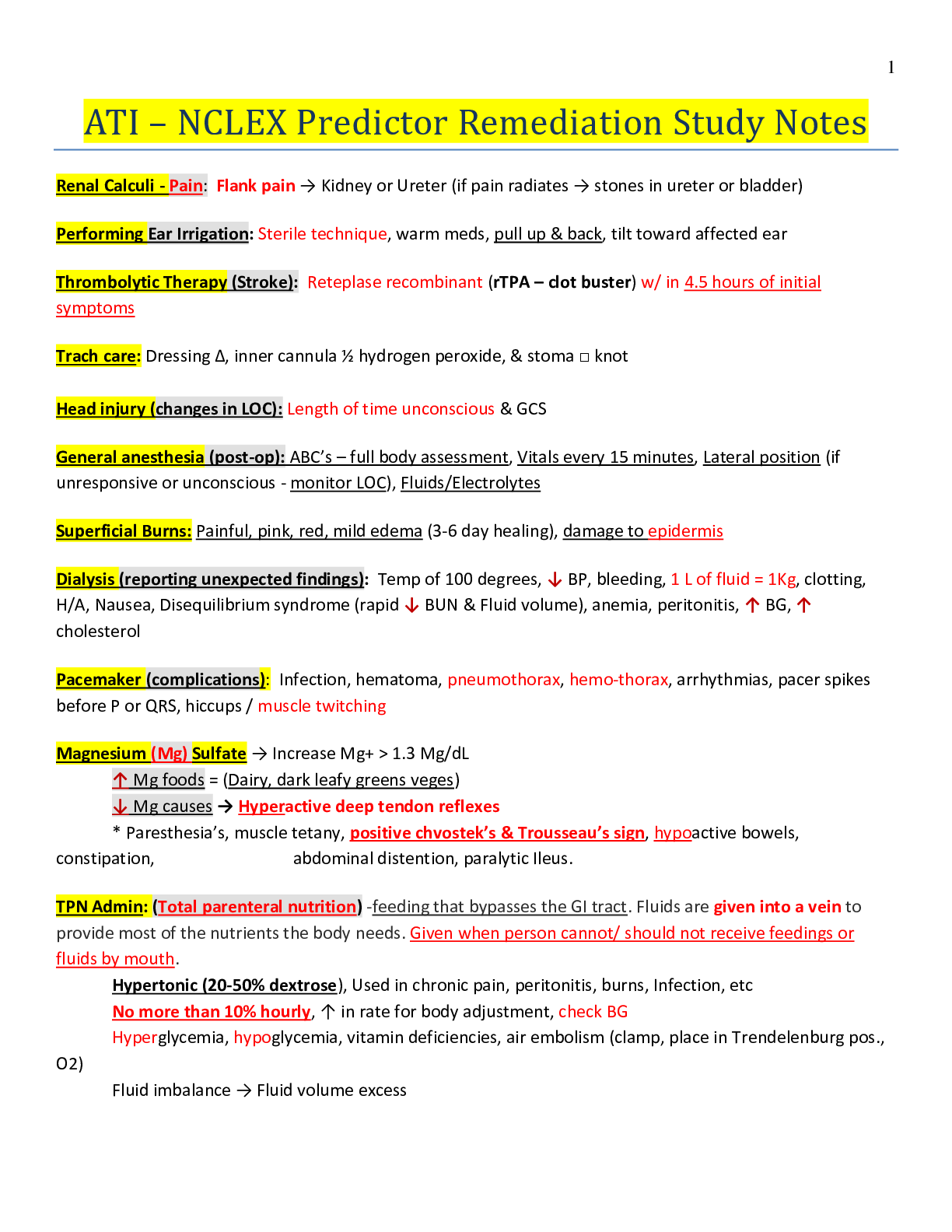


.png)

